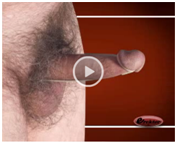Cystogram image is shown below
There is contrast
in the bladder.
True
False
There is contrast
in the perivesical space.
True
False
There is contrast
in the peritoneal cavity.
True
False
CT images of the abdomen and
pelvis
Images
from unenhanced CT the abdomen and pelvis performed immediately after cystogram
are shown below
What is the final
diagnosis?
Ureteral
injury
Extraperitoneal
bladder rupture
Collecting
system injury
Intraperitoneal
bladder rupture
What is the next
step in management?
Additional
imaging to evaluate the bladder.
Transurethral
Foley catheter drainage
Suprapubic
catheter drainage
Operative
management
Findings and diagnosis
Findings
- Cystogram
- Extravasation from the urinary
bladder into the peritoneal cavity, with contrast extending into the
paracolic gutters
- Metallic density in the left
pelvis, consistent with shrapnel
- Unenhanced CT of the abdomen and pelvis,
performed immediately after cystogram
- Large amount of
intraperitoneal high-density fluid in the subhepatic space, paracolic
gutters and within the peritoneal cavity, representing contrast from
cystogram performed prior to the CT scan
Differential
diagnosis
- Intraperitoneal bladder rupture
- Extraperitoneal bladder rupture
- Ureteral injury
- Collecting system injury
Diagnosis: Intraperitoneal bladder
rupture
- Etiology
- Bladder injury is most commonly seen in
the setting of motor vehicle collisions.
- Bladder trauma occurs from blunt injury
and penetrating or iatrogenic trauma.
- Often associated with pelvic fractures.
- Classification of bladder injury
- Type 1: Simple bladder contusion is a
mucosal injury and does not have detectable abnormalities on imaging
studies.
- Type 2: Intraperitoneal rupture is the
result of a direct blow to an already distended bladder, which increases
intraluminal pressure and causes rupture of the dome of the bladder.
Intraperitoneal bladder injury accounts for about one-third of all major
bladder injuries.
- Type 3: Interstitial injury is an
intramural or partial thickness laceration with an intact serosa. This
type of injury is rare and would be difficult to recognize on imaging
studies.
- Type 4: Extraperitoneal rupture is the most
common type of bladder injury, and accounts for approximately 60% of
major bladder injuries.
- Type 4A: Simple
extraperitoneal rupture has extravasation limited to the perivesical
space.
- Type 4B: Complicated
extraperitoneal rupture has extravasation beyond the perivesical space.
- Type 5: Combined injury is a combination of
intraperitoneal and extraperitoneal injury, and accounts for 5% of all
bladder injuries.
- Clinical presentation
- Gross hematuria
- Suprapubic pain
- Anuria
- Decreased bowel sounds (with intraperitoneal
injury)
- Acute abdomen (with intraperitoneal
injury)
- Laboratory findings
- Urinanalysis will demonstrate hematuria.
- Peritoneal lavage fluid will be
consistent with urine.
- Imaging recommendations
- Cystography -- CT or conventional (equal
sensitivity).
- Exclude urethral injury in males before
performing cystography.
- Check postdrainage films to identify
extravasation that was hidden by contrast.
- Radiographic findings
- Cystography
- Bladder contusion: Usually not
recognized by imaging, but may have teardrop appearance of bladder due
to extrinsic compression of bladder by bladder hematoma.
- Intraperitoneal: Extravasation of
contrast around bowel loops, paracolic gutters, pouch of Douglas, and
intraperitoneal viscera.
- Interstitial injury: Focal defect along
the wall of the bladder may be seen, but is difficult to recognize on
imaging.
- Extraperitoneal:
- Simple: Extravasation around the
bladder.
- Complex: Extravasation extends beyond
the pelvis.
- Combined: Findings of both
intraperitoneal and extraperitoneal rupture.
- CT cystography
- Contusion: Normal appearance.
- Intraperitoneal: Same findings as
conventional cystogram.
- Interstitial: Extravasation of contrast
intramurally and submucosally without transmural extension, but
difficult to recognize on imaging.
- Extraperitoneal rupture:
- Simple: Contrast is confined to
perivesical space.
- Complex: Contrast extends beyond the
perivesical space.
- "Molar tooth" sign -- rounded
superiorly with pointed inferior contours.
- Ultrasound
- Fluid around the bladder
- Hematoma within bladder wall
- Complications include fistulas, abscess,
sepsis, hematoma, and hemorrhage.
- Management is determined by classification
of injury.
- Contusions and interstitial injuries are
managed conservatively with Foley catheterization.
- Intraperitoneal injury requires
laparotomy and surgical repair of bladder injury.
- Extraperitoneal injury is usually treated
with catheter drainage. If there is complicated extraperitoneal rupture,
then surgical repair may be necessary.
- Follow-up: Perform cystography 10 days
after initiation of treatment.
References
1.
Chan DP, Abujudeh HH, Cushing GL
Jr, Novelline RA. CT cystography with multiplanar reformation for suspected
bladder rupture: Experience in 234 cases. AJR Am J Roentgenol. 2006:187(5);1296-1302.
2.
Ramchandani P, Buckler PM. Imaging
of genitourinary trauma. AJR Am J Roentgenol. 2009;192(6):1514-23..
Vaccaro
JP, Brody JM. CT cystography in the evaluation of major bladder trauma. Radiographics.2000;20(5):1373-1381.








